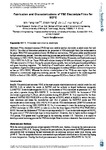Fabrication and Characterizations of YSZ Electrolyte Films for SOFC
| dc.contributor.author | Han, M-F | en |
| dc.contributor.author | Yang, Z | en |
| dc.contributor.author | Liu, Z | en |
| dc.contributor.author | Le, H-R | en |
| dc.contributor.editor | Pan, W | en |
| dc.contributor.editor | Gong, J | en |
| dc.date.accessioned | 2015-02-23T12:01:11Z | |
| dc.date.available | 2015-02-23T12:01:11Z | |
| dc.date.issued | 2010-01-01 | en |
| dc.identifier.issn | 1013-9826 | en |
| dc.identifier.uri | http://hdl.handle.net/10026.1/3263 | |
| dc.description | 6th China International Conference on High-Performance Ceramics (CICC-6), Harbin, PEOPLES R CHINA, AUG 16-19, 2009 affiliation: Han, MF (Reprint Author), China Univ Min & Technol, Sch Chem & Environm Engn, Union Res Ctr Fuel Cell, Beijing 100083, Peoples R China. [Han, Min-Fang; Yang, Zhibin; Liu, Ze] China Univ Min & Technol, Sch Chem & Environm Engn, Union Res Ctr Fuel Cell, Beijing 100083, Peoples R China. keywords: SOFC; Yttria stabilized zirconia; electrolyte keywords-plus: ZIRCONIA; POWDERS; MICROSTRUCTURE; CONDUCTIVITY; CATHODE; GROWTH; ZRO2 subject-category: Materials Science, Ceramics; Materials Science, Composites author-email: hanminfang@sina.com number-of-cited-references: 24 times-cited: 0 doc-delivery-number: BPZ23 unique-id: ISI:000280417300189 | en |
| dc.description.abstract |
Yttria stabilized zirconia (YSZ) has been widely used as electrolyte in solid oxide fuel cell (SOFC). The effect of fabrication process on the properties of YSZ electrolyte thick film is discussed in the paper. With YSZ nano-powders of about 20-60nm as raw material, YSZ green adobe was fabricated by tape calendering process. Three-step sintering process was performed firstly holding at 1000 degrees C for 2h, then raising to 1300 similar to 1400 degrees C, then decreasing to 1200 similar to 1300 degrees C within 30 minutes, and finally calcining at 1200 similar to 1300 degrees C for 5 similar to 20 hrs. Dense YSZs with relative density of 96-99% are obtained; the grain size of YSZ was reduced to 0.5-3 mu m. During the process of grain growth, there are both grain boundary diffusion and grain boundary migration. The feasibility of densification without grain growth relies on the suppression of grain boundary migration while keeping grain boundary diffusion active at a temperature as low as 1200 similar to 1300 degrees C. Whereas the electric conductivities of the YSZs are even higher than that obtained in conventional single step sintering process. The process is applied to the anode-supported SOFCs co-fired at 1250 similar to 1300 degrees C, and the cathode-supported SOFCs co-fired at 1200 similar to 1250 degrees C. | en |
| dc.format.extent | 705 - 709 | en |
| dc.language.iso | en | en |
| dc.publisher | TRANS TECH PUBLICATIONS LTD | en |
| dc.title | Fabrication and Characterizations of YSZ Electrolyte Films for SOFC | en |
| dc.type | Conference Contribution | |
| plymouth.volume | 434-435 | en |
| plymouth.journal | HIGH-PERFORMANCE CERAMICS VI | en |
| dc.identifier.doi | 10.4028/www.scientific.net/KEM.434-435.705 | en |
| plymouth.organisational-group | /Plymouth | |
| plymouth.organisational-group | /Plymouth/Research Groups | |
| plymouth.organisational-group | /Plymouth/Research Groups/Marine Institute | |
| dc.publisher.place | LAUBLSRUTISTR 24, CH-8717 STAFA-ZURICH, SWITZERLAND | en |
| dc.rights.embargoperiod | Not known | en |
| rioxxterms.versionofrecord | 10.4028/www.scientific.net/KEM.434-435.705 | en |
| rioxxterms.licenseref.uri | http://www.rioxx.net/licenses/all-rights-reserved | en |
| rioxxterms.type | Conference Paper/Proceeding/Abstract | en |


